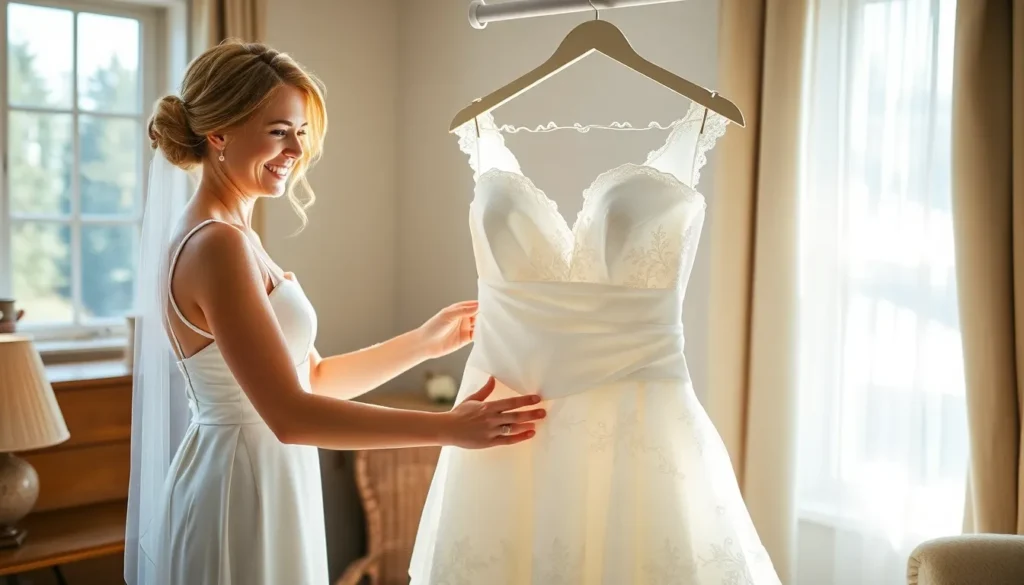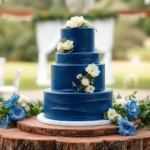Your wedding dress represents one of life’s most precious memories and likely one of your biggest fashion investments. After walking down the aisle in your dream gown we understand you’ll want to preserve its beauty for years to come. Whether you’re hoping to pass it down to future generations or simply keep it as a cherished keepsake your dress deserves proper care and attention.
Wedding dress preservation isn’t just about storing your gown in a closet and hoping for the best. Different fabrics require exact treatment methods and without proper preservation techniques your beautiful dress could yellow discolor or develop permanent stains over time. We’ve seen too many brides heartbroken when they discover their poorly stored dress has deteriorated beyond repair.
That’s why we’ve compiled the most effective wedding dress preservation methods that actually work. From professional cleaning services to DIY storage answers we’ll guide you through proven techniques that keep your gown looking as stunning as your wedding day for decades to come.
Clean Your Wedding Dress Immediately After the Ceremony
Acting fast after your wedding ceremony gives you the best chance to preserve your dress’s pristine condition. Fresh stains respond much better to cleaning efforts than those that have set into the fabric over time.
Remove Stains While They’re Fresh
Blotting stains immediately prevents them from penetrating deeper into wedding dress fibers. We recommend keeping a wedding day emergency kit with white cotton cloths and distilled water for quick stain removal.
Makeup stains respond well to gentle dabbing with a clean white cloth. Press the cloth against the stain without rubbing to avoid spreading the makeup further across the fabric.
Dirt and mud marks should be allowed to dry completely before attempting removal. Shake off dried dirt particles first, then use a soft brush to gently work remaining residue from the fabric.
Wine and champagne spills require immediate attention with club soda or white wine to neutralize the stain. Pour a small amount directly onto the affected area and blot with a clean cloth.
Address Sweat and Deodorant Marks
Perspiration stains become permanent when left untreated, creating yellow discoloration that’s nearly impossible to remove later. Wedding dress preservation depends heavily on addressing these marks within 24 hours of your ceremony.
Underarm areas typically show the most sweat and deodorant buildup after wedding celebrations. Mix equal parts white vinegar and water to create a gentle solution for treating these sensitive areas.
Bodice sections where antiperspirant transfers onto fabric need special attention. Apply the vinegar solution with a clean cotton swab, working from the outside of the stain toward the center.
Neckline and back areas often retain perspiration that isn’t immediately visible. Check these zones carefully under good lighting and treat any dampness with the same vinegar solution.
Handle Food and Drink Spills Promptly
Wedding reception dining creates many opportunities for food and beverage accidents on your dress. Quick response to these spills makes the difference between successful stain removal and permanent damage.
Grease-based stains from wedding cake frosting or appetizers need cornstarch or baby powder applied immediately. Sprinkle the powder generously over the stain and let it absorb oils for 10-15 minutes before brushing away.
Tomato-based sauces from cocktail hour appetizers should be scraped gently with a spoon before treatment. Rinse the area with cold water from the back of the fabric to push the stain out rather than deeper in.
Chocolate and dessert marks respond best to ice cubes applied directly to harden the chocolate first. Scrape away hardened pieces with a butter knife, then treat remaining residue with cold water and gentle dish soap.
Choose Professional Cleaning Over DIY Methods
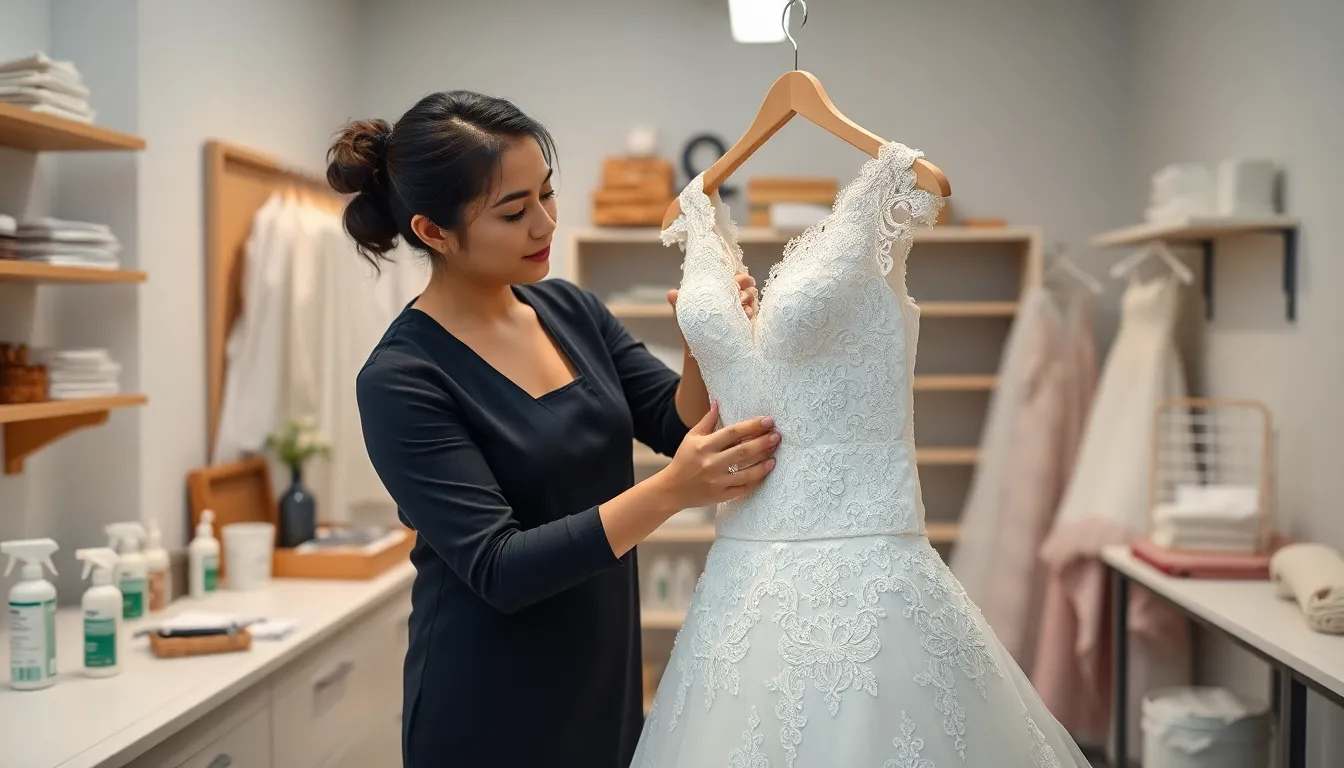
Professional cleaning offers superior results compared to DIY approaches because wedding dresses contain intricate details and delicate fabrics that require specialized expertise. We recommend entrusting your gown to professionals who assess each dress individually based on fabric type and embellishments before beginning the cleaning process.
Research Specialized Wedding Dress Cleaners
Look for cleaners who specialize specifically in wedding dress preservation rather than general garment cleaning. These professionals understand the unique challenges of preserving bridal gowns and use proven methods to maintain fabric integrity. GreenEarth Cleaning technology provides gentle yet effective cleaning that’s safer for delicate fabrics like silk, lace, and tulle. Elegant Care wet cleaning methods offer another trusted approach for preserving wedding dresses without harsh chemicals.
Consider cleaners who offer the Prestige Preservation Program, which safeguards against yellowing and deterioration over time. This specialized service includes detailed inspection, targeted stain removal, and preservation techniques designed specifically for wedding dresses. Research customer reviews and ask about their experience with gowns similar to yours in terms of fabric and embellishment complexity.
Avoid Regular Dry Cleaning Services
Skip conventional dry cleaning services that may damage or discolor your wedding dress fabrics. Regular dry cleaners often use harsh chemicals and standardized processes that aren’t suitable for delicate bridal materials. These services frequently fail to address invisible stains that can become permanent over time if not properly treated.
Traditional dry cleaning methods can cause important damage to wedding dress embellishments like beading, sequins, and lace appliques. The aggressive chemicals and tumbling action used in standard dry cleaning can loosen threads, fade colors, and break delicate decorative elements. Many regular dry cleaners lack the specialized knowledge needed to handle the variety of fabrics and construction techniques found in wedding dresses.
Request Eco-Friendly Cleaning Answers
Choose eco-friendly cleaning answers that use GreenEarth technology for gentler fabric treatment. These environmentally conscious methods protect both your dress and the environment while delivering exceptional cleaning results. Eco-friendly answers reduce the risk of chemical damage to delicate fabrics and minimize exposure to harsh toxins.
Ask about water-based cleaning alternatives that avoid petroleum-based solvents entirely. These methods effectively remove stains and soil while being gentler on sensitive fabrics like silk and vintage lace. Many eco-friendly cleaning processes also help preserve the natural oils in fabrics, maintaining their softness and flexibility over time.
Select the Right Preservation Storage Method
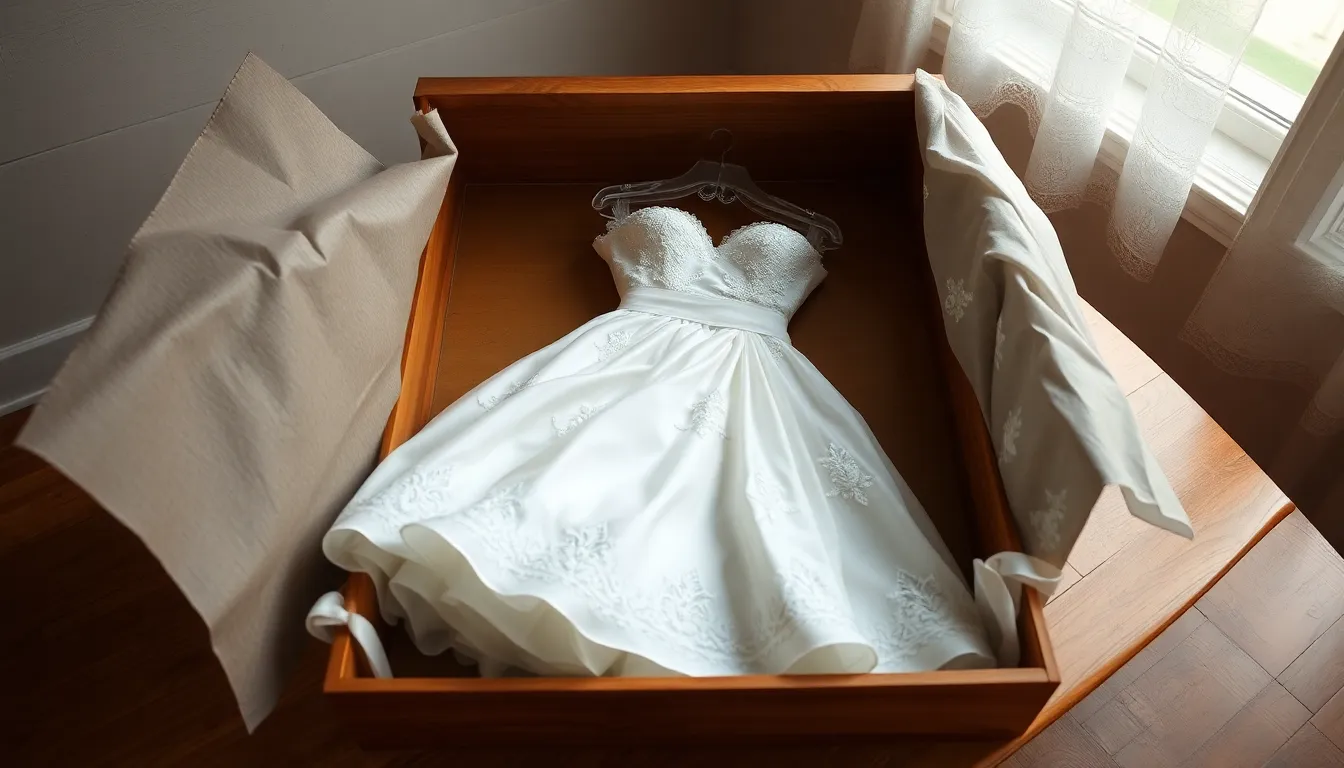
Choosing the proper storage method forms the foundation of successful wedding dress preservation. We must avoid common mistakes that can damage your gown over time.
Consider Acid-Free Preservation Boxes
Acid-free preservation boxes offer the gold standard for wedding dress storage. We recommend wrapping your dress completely in acid-free tissue paper before placing it in an acid-free storage box to prevent yellowing and fabric deterioration.
Regular cardboard boxes contain acids that can cause permanent discoloration over years of storage. Acid-free materials maintain their pH neutrality, protecting delicate fabrics from chemical reactions that lead to browning or weakening of fibers.
Storage materials require replacement every three years to maintain their protective effectiveness. We suggest marking your calendar to remind yourself of this crucial maintenance step, as even acid-free materials can lose their protective properties over time.
Explore Museum-Quality Storage Options
Museum-quality preservation methods provide the highest level of protection available for wedding dresses. We’ve found that programs like the Prestige Preservation Program use techniques identical to those employed by museums to store historical textiles.
These specialized services prevent yellowing, fading, and fabric deterioration through controlled environments and archival-quality materials. Professional preservation specialists understand the unique requirements of different fabric types, from silk and satin to lace and beadwork.
Temperature and humidity control distinguish museum-quality storage from standard preservation methods. We recommend these services for heirloom-quality dresses or gowns with important sentimental value that you plan to pass down through generations.
Evaluate Vacuum-Sealed Preservation Bags
Vacuum-sealed bags create more problems than they solve for wedding dress storage. We strongly advise against using these products because they trap moisture inside the sealed environment, leading to mildew growth and potential fabric damage.
Breathable storage answers allow air circulation that prevents moisture buildup and bacterial growth. Acid-free boxes with proper ventilation maintain the ideal storage environment without creating the sealed conditions that promote deterioration.
Commercial vacuum-sealing also compresses delicate fabrics and embellishments, potentially causing permanent creasing or damage to three-dimensional elements like flowers, bows, or beading. We’ve seen too many preserved dresses emerge from vacuum bags with irreversible compression damage to recommend this storage method.
Control Environmental Factors in Storage Areas
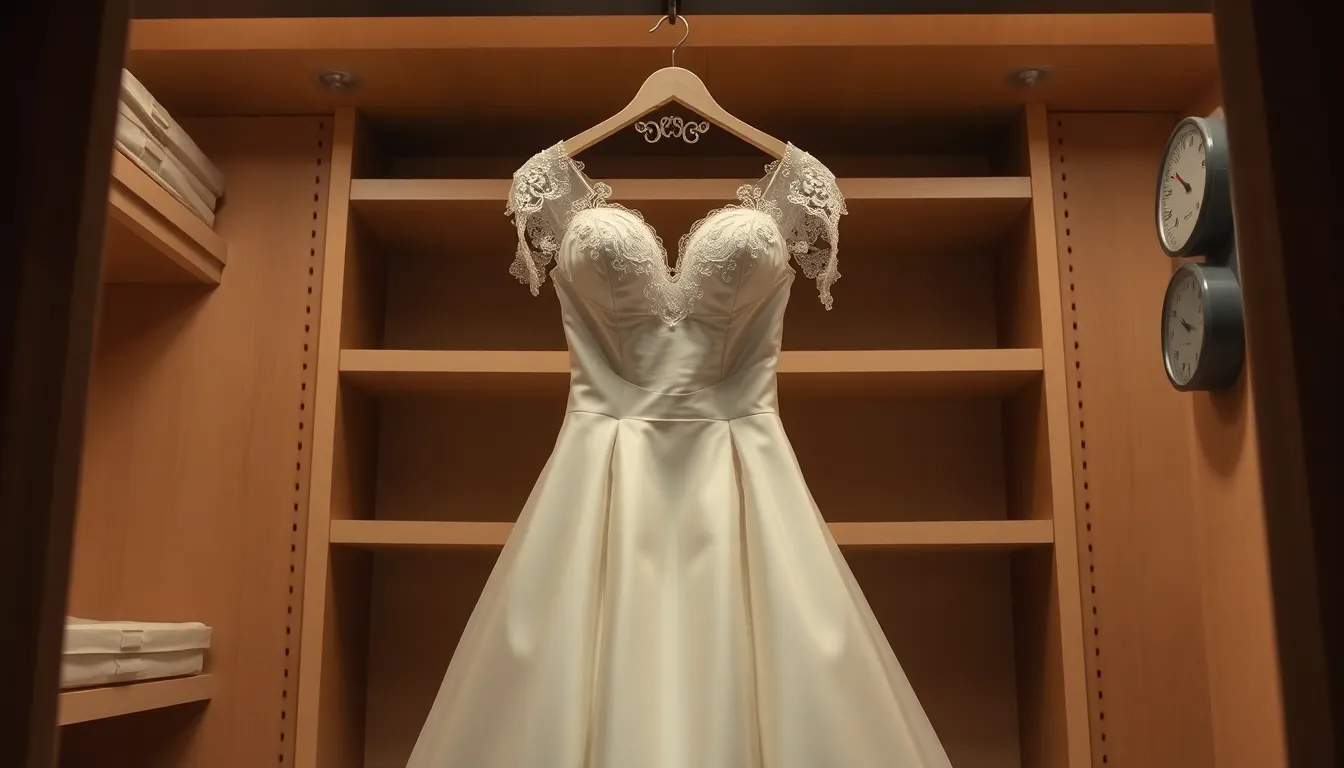
Environmental conditions play a crucial role in wedding dress preservation success. We’ll examine the three most critical factors that determine whether your gown maintains its beauty or suffers irreversible damage.
Maintain Consistent Temperature Levels
Temperature fluctuations can cause fabric fibers to expand and contract, leading to permanent damage over time. We recommend storing your wedding dress in a cool location between 60°F and 70°F to prevent degradation and maintain fabric integrity.
Basements and attics aren’t ideal storage locations due to their extreme temperature variations throughout seasons. Climate-controlled areas like bedroom closets or spare rooms provide the stable environment your dress needs for long-term preservation.
Excessive heat accelerates chemical reactions that cause yellowing and fabric breakdown. Freezing temperatures can make delicate fabrics brittle and prone to cracking when disturbed.
Monitor Humidity Levels Carefully
Humidity control prevents the growth of mold, mildew, and bacteria that can permanently stain or destroy wedding dress fabrics. We suggest maintaining humidity levels below 60% to create an environment where harmful microorganisms can’t thrive.
High humidity creates moisture buildup that leads to musty odors and fabric deterioration. Low humidity levels can cause natural fibers like silk and cotton to become brittle and tear easily.
Humidity monitoring devices help track moisture levels in your storage area throughout different seasons. Digital hygrometers provide accurate readings and alert you when adjustments are needed to maintain optimal conditions.
Ensure Proper Air Circulation
Air circulation prevents moisture accumulation and maintains stable humidity levels around your stored wedding dress. We emphasize using storage methods that allow airflow while protecting the gown from dust and light exposure.
Sealed containers without ventilation create stagnant air pockets where moisture can concentrate and cause damage. Breathable storage answers like cotton garment bags or acid-free boxes with ventilation holes promote healthy air movement.
Proper ventilation also helps regulate temperature by preventing hot spots that can accelerate fabric aging. Strategic placement of your storage container away from heating vents and exterior walls ensures consistent airflow without direct exposure to temperature extremes.
Prepare Your Dress Properly Before Storage
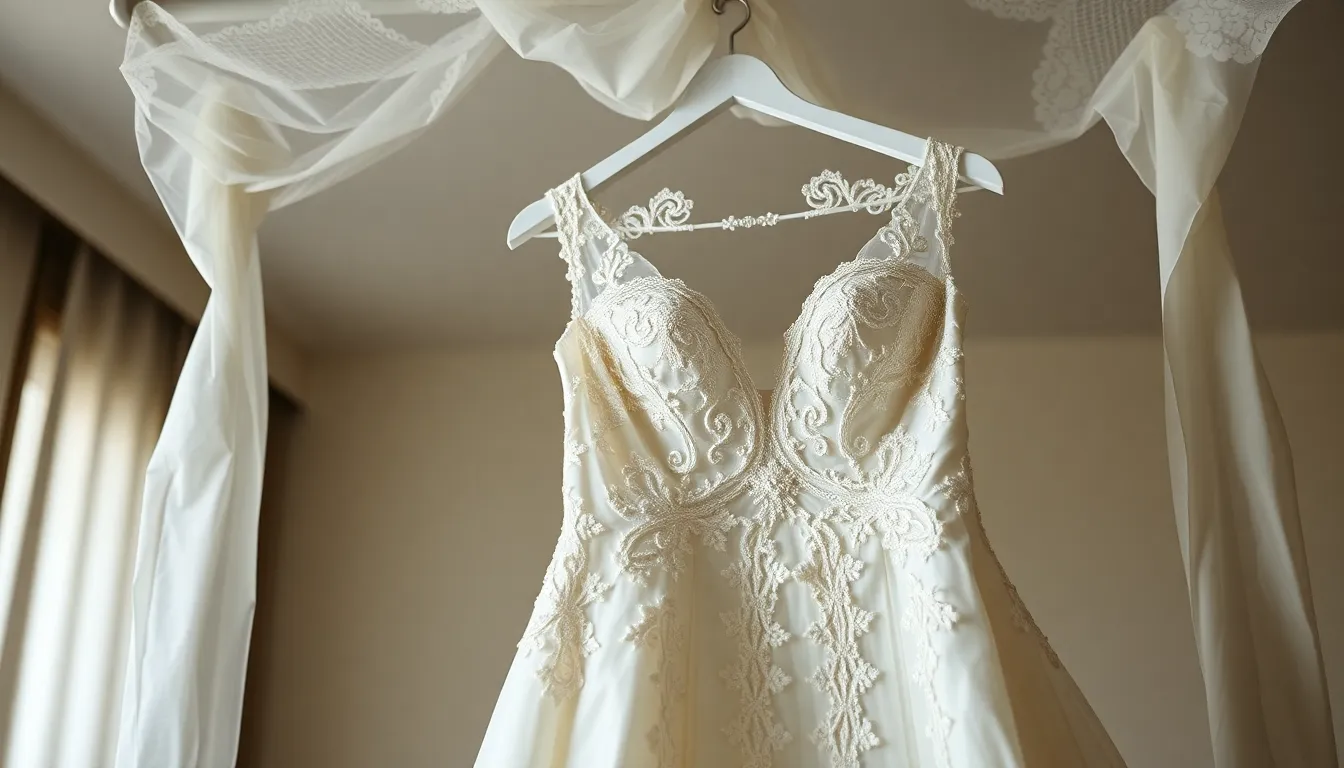
Professional cleaning marks the first crucial step in preservation. Now we’ll focus on essential preparation techniques that protect your gown’s structure and beauty during long-term storage.
Add Acid-Free Tissue Paper for Shape Support
Use acid-free tissue paper to maintain your wedding dress’s original silhouette throughout storage. Regular tissue paper contains acids that degrade over time and release damaging chemicals that can harm delicate fabrics, causing permanent yellowing and deterioration.
Place generous amounts of acid-free tissue inside sleeves to prevent crushing and maintain their shape. Stuff the bodice area thoroughly to support structured elements like boning or padding. Fill all natural folds and creases with tissue to prevent permanent creasing that can weaken fabric fibers over time.
Layer tissue paper between multiple fabric layers if your dress features overlays or tiered skirts. This prevents different materials from rubbing against each other and causing friction damage. Replace storage tissue every few years to maintain optimal preservation conditions and ensure continued protection.
Wrap Delicate Embellishments Separately
Protect intricate beadwork by wrapping clusters of beads individually with small pieces of acid-free tissue paper. Beading can catch on other parts of the dress during storage, potentially causing tears or lost embellishments that are difficult to repair or replace.
Cushion sequined areas with extra layers of tissue to prevent scratching adjacent fabric surfaces. Sequins have sharp edges that can cut delicate materials like silk or chiffon when pressure is applied during storage. Create protective barriers around all sequined sections to eliminate friction contact.
Secure loose lace details by gently placing tissue underneath and around each piece. Antique or handmade lace is particularly fragile and can tear easily if not properly supported. Wrap removable elements like detachable trains or sleeves separately in their own acid-free tissue before placing them alongside the main gown.
Document the Dress Condition with Photos
Take comprehensive photographs of your wedding dress from multiple angles before storage begins. Capture close-up shots of intricate details like beadwork, lace patterns, and embroidered elements to create a complete visual record of the gown’s current condition.
Document any existing stains, small tears, or loose embellishments with detailed photos for future reference. These images serve as valuable documentation for insurance claims and help restoration professionals understand the dress’s original state if repairs become necessary years later.
Create a photo inventory that includes shots of the dress laid flat, hanging, and from various angles. Store digital copies in multiple locations including cloud storage to ensure you’ll have access to these important records throughout the preservation period.
Store Accessories and Undergarments Separately
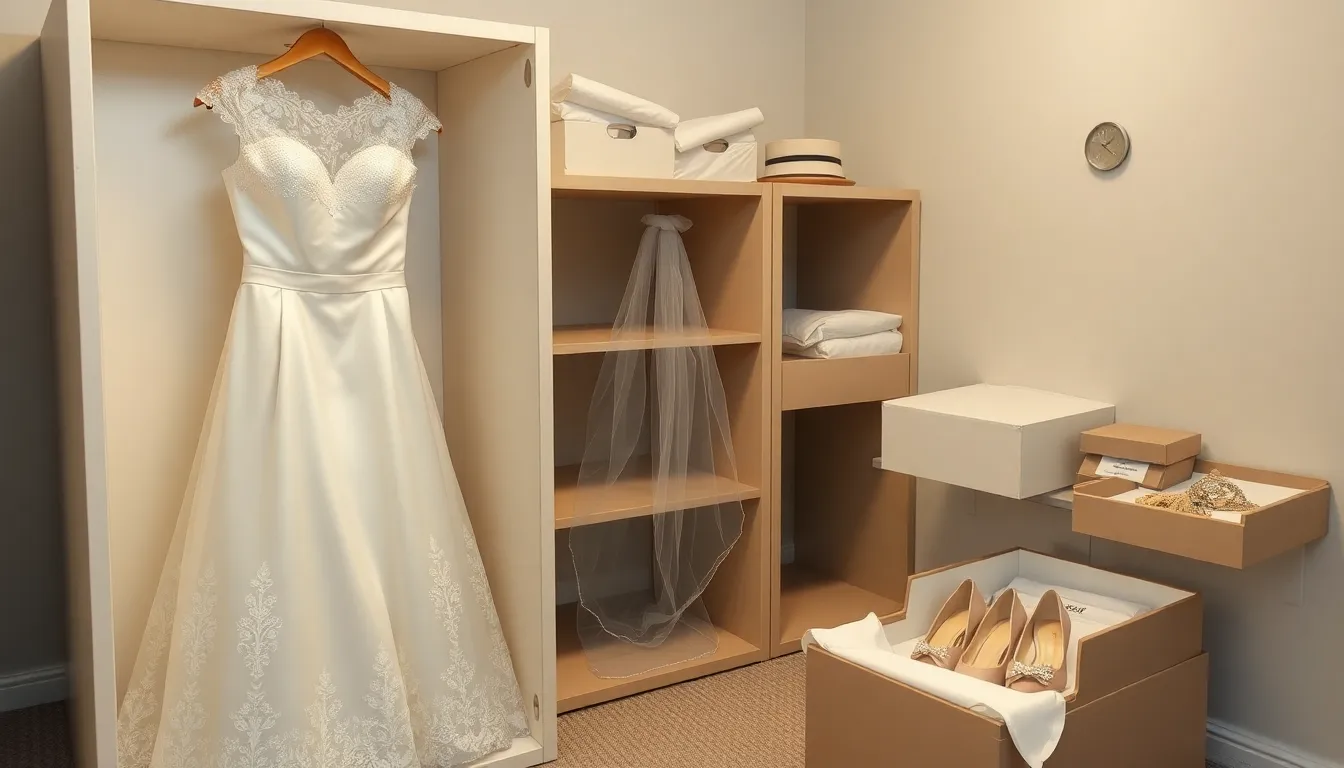
Wedding dress accessories require individual storage answers to prevent damage and maintain their pristine condition. Separate storage containers protect delicate items from transferring stains, odors, or moisture to your preserved gown.
Preserve Your Veil Using Specialized Techniques
Veils demand specialized cleaning services due to their delicate construction and intricate lace or beading details. Professional cleaners understand the unique requirements of different veil materials, from silk tulle to vintage lace, ensuring proper treatment without causing tears or discoloration.
Store your cleaned veil in a separate acid-free box lined with tissue paper to prevent it from tangling with your dress. Roll longer veils carefully around acid-free tubes to maintain their shape and prevent creasing. Layer tissue paper between each fold to create protective barriers that prevent fabric-to-fabric contact.
Position your veil storage container in the same climate-controlled environment as your dress to ensure consistent preservation conditions. Keep the veil box away from direct contact with your dress storage to prevent any potential transfer of cleaning residues or environmental contaminants.
Store Shoes in Individual Containers
Wedding shoes require individual containers to prevent scuffing, moisture transfer, and shape distortion during long-term storage. Clean your shoes thoroughly before storage, removing dirt, grass stains, and any dance floor residue that could attract pests or cause permanent staining.
Stuff each shoe with acid-free tissue paper to maintain its original shape and prevent the leather or fabric from collapsing over time. Wrap each shoe separately in breathable cotton muslin or acid-free tissue before placing them in individual boxes or containers.
Store shoe boxes in a cool, dry location separate from your dress storage area to prevent any potential moisture or odor transfer. Label each container with the contents and storage date to help you track the preservation timeline and assess condition during periodic inspections.
Keep Jewelry in Anti-Tarnish Storage
Wedding jewelry requires anti-tarnish storage answers to prevent oxidation and discoloration that can occur over time. Store each piece in individual anti-tarnish pouches or boxes designed specifically for jewelry preservation, as these containers contain special materials that absorb moisture and prevent chemical reactions.
Separate different metal types into distinct storage compartments to prevent galvanic corrosion, which occurs when dissimilar metals come into contact. Silver pieces need particular attention, as they tarnish more quickly than gold or platinum items when exposed to air and moisture.
Document each jewelry piece with photographs and written descriptions before storage, noting any existing wear or damage for future reference. Store jewelry containers in a location separate from your dress and other accessories to prevent any potential chemical interactions or moisture transfer that could affect the preservation quality.
Inspect Your Preserved Dress Annually

Annual inspections help us catch potential preservation problems before they become irreversible damage. We can protect our investment by establishing a consistent monitoring routine.
Check for Signs of Yellowing or Discoloration
Exposure to environmental factors like light, humidity, or acidic conditions causes yellowing and discoloration over time. We should examine the entire gown carefully, paying special attention to areas that were once stained or came into contact with body oils during the wedding day.
Start your inspection by unfolding the dress in a well-lit area away from direct sunlight. Look for subtle color changes, particularly in white or ivory fabrics that show discoloration most readily. Focus on the neckline, underarms, and hemline where stains commonly develop into permanent discoloration.
Document any changes you notice with photographs to track the progression over time. Compare these images to your pre-storage documentation to identify new issues that require professional attention. Early detection allows us to address problems before they spread or become embedded in the fabric fibers.
Look for Pest Damage or Moisture Issues
Check for evidence of pest damage, such as insect holes or droppings, and moisture problems like mildew or musty odors, which can accelerate deterioration. We need to examine every fold and layer of the dress systematically to identify these threats early.
Inspect the storage container first, looking for signs of insect activity around the edges and corners. Small holes in the fabric, tiny brown or black specks, or shed insect parts indicate pest infiltration that requires immediate intervention. Moths and carpet beetles particularly target natural fibers found in many wedding dresses.
Smell the dress and storage materials for musty or sour odors that signal moisture accumulation. Touch the fabric gently to detect any dampness or unusual texture changes that suggest mold or mildew growth. These moisture issues can spread rapidly and cause permanent staining or fabric weakening if left untreated.
Refold the Dress to Prevent Permanent Creases
Take the opportunity to refold the dress to avoid permanent creases and redistribute stress points on the fabric during your annual inspection. We can prevent long-term damage by changing fold lines and allowing different areas of the dress to bear storage stress.
Unfold the dress completely and examine the existing crease lines for any signs of fabric weakness or permanent marking. Smooth out the fabric gently with clean hands, allowing wrinkles to relax naturally before creating new fold patterns. Choose different folding points than the previous year to distribute tension across various areas of the gown.
Replace the acid-free papers and box every few years as recommended by preservation experts while refolding your dress. Fresh tissue paper maintains its protective properties and prevents acid transfer that can occur as materials age. Layer new acid-free tissue between each fold, ensuring adequate cushioning at stress points like the bodice, sleeves, and train areas.
Plan for Future Use or Display Options
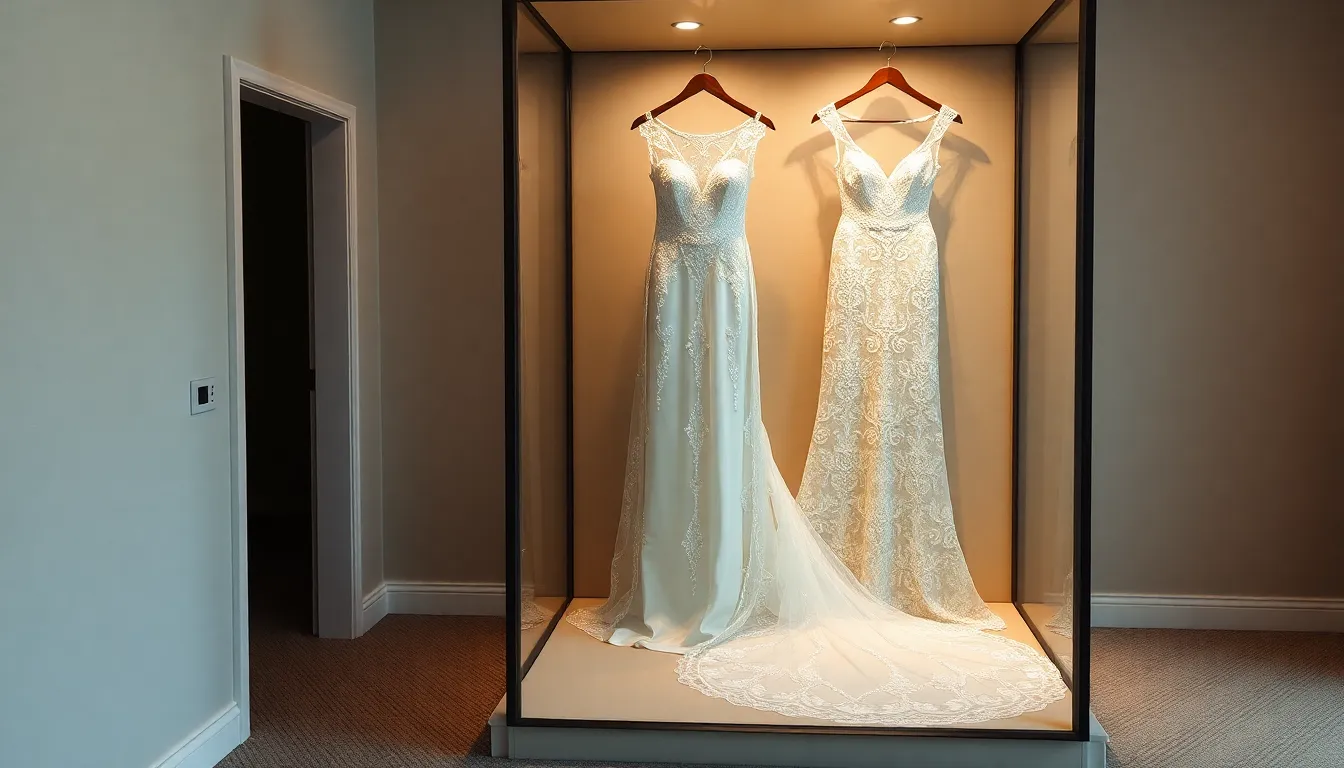
After establishing proper storage conditions and completing your annual inspection routine, it’s time to consider your wedding dress’s long-term future. Planning ahead ensures your gown serves its intended purpose for years to come.
Consider Heritage Preservation for Future Generations
Museum-grade preservation techniques safeguard wedding dresses against fading and deterioration for decades. Professional cleaning and preservation services remove stains while preventing future yellowing, ensuring the dress remains a cherished family heirloom. We recommend selecting preservation specialists who use archival-quality materials and controlled environments to maintain fabric integrity.
Documentation plays a crucial role in heritage preservation planning. Photography captures every detail of your dress’s current condition, creating a visual record for future generations. Written descriptions of fabric types, embellishments, and sentimental significance provide context that enhances the dress’s family history value.
Storage location considerations become essential for generational preservation. Climate-controlled environments protect against temperature fluctuations that can cause irreversible fabric damage. Acid-free preservation boxes prevent yellowing while maintaining proper air circulation around delicate materials.
Explore Professional Display Case Options
Acid-free display cases provide optimal protection while showcasing your wedding dress beautifully. These specialized cases prevent chemical reactions that cause fabric discoloration and maintain stable environmental conditions. Professional display answers offer visibility without compromising preservation quality.
Customized cases fit your dress perfectly, providing additional protection and enhanced visual appeal. Custom-made options accommodate unique dress features like long trains, intricate beadwork, or voluminous skirts. We suggest consulting with display case specialists who understand wedding dress preservation requirements.
UV-resistant glass protects fabrics from light damage while maintaining clarity for viewing. Sealed environments within display cases control humidity levels and prevent dust accumulation. Professional installation ensures proper ventilation systems that circulate air without compromising the controlled environment.
Research Alteration Possibilities for Future Wear
Alteration services offered by preservation specialists allow wedding dresses to fit future generations perfectly. Some professional preservation companies provide modification options that maintain the dress’s structural integrity while accommodating different body types. We recommend consulting with experts who specialize in vintage and preserved garment alterations.
Structural assessment determines whether alterations are possible without compromising the dress’s historical value. Fabric condition, seam construction, and embellishment placement all influence alteration feasibility. Professional evaluation prevents damage that could occur from inappropriate modification attempts.
Reversible alteration techniques preserve the dress’s original design while allowing temporary modifications. Basting methods and removable structural changes enable future adjustments without permanent alterations. Documentation of any modifications maintains the dress’s provenance for future preservation decisions.
Conclusion
We’ve covered the essential strategies for preserving your wedding dress from the moment you take it off until it’s safely stored for years to come. By following these proven methods you’ll protect your investment and ensure your gown remains beautiful for future generations.
Remember that proper preservation isn’t just about storage – it’s about immediate care professional cleaning and creating the right environment for long-term protection. Whether you’re planning to pass down your dress as a family heirloom or simply want to preserve the memories it represents taking action now will save you from irreversible damage later.
Start with professional cleaning choose acid-free storage materials and maintain consistent environmental conditions. Your wedding dress deserves the same care and attention you gave to choosing it in the first place.
Frequently Asked Questions
Why is professional cleaning better than DIY methods for wedding dress preservation?
Professional cleaners specialize in delicate fabrics and intricate details found in wedding dresses. They use gentle cleaning methods like GreenEarth Cleaning technology and Elegant Care wet cleaning that are specifically designed for bridal gowns. Regular dry cleaning can damage or discolor wedding dress fabrics due to harsh chemicals and standardized processes that aren’t suitable for such delicate garments.
How soon after the wedding should I clean my dress?
You should clean your wedding dress as soon as possible after the ceremony, ideally within 24 hours for perspiration stains. Fresh stains respond much better to cleaning efforts than set-in stains. Keep a wedding day emergency kit handy for quick stain removal of makeup, dirt, wine, and food spills to prevent permanent damage.
What’s the best storage method for wedding dress preservation?
Use acid-free preservation boxes to prevent yellowing and fabric deterioration. Avoid regular cardboard boxes which can cause permanent discoloration. For heirloom dresses, consider museum-quality storage with controlled environments and archival materials. Never use vacuum-sealed bags as they trap moisture and can lead to mildew growth.
What environmental conditions are ideal for storing a wedding dress?
Maintain consistent temperature between 60°F and 70°F, avoiding basements and attics with temperature fluctuations. Keep humidity levels below 60% to prevent mold and mildew growth. Ensure proper air circulation with breathable storage methods that protect from dust and light while allowing airflow to prevent moisture accumulation.
Should I store wedding dress accessories with the dress?
No, store accessories separately to prevent damage. Veils need specialized cleaning and acid-free box storage with tissue paper lining. Clean shoes and stuff with tissue, storing in individual containers. Keep jewelry in anti-tarnish storage to prevent oxidation. Maintain consistent climate conditions for all stored items.
How often should I check on my preserved wedding dress?
Conduct annual inspections to catch potential problems early. Check for yellowing, discoloration, pest damage, and moisture issues. Refold the dress periodically to prevent permanent creases. Document any changes and replace acid-free materials as needed to ensure the dress remains in excellent condition over time.
Can a preserved wedding dress be altered for future generations?
Yes, with proper planning and reversible alteration techniques. Professional alterations can modify the dress to fit different generations without compromising the original design. Use museum-grade preservation and documentation to maintain the dress’s family history value while allowing for future modifications that preserve its provenance.

